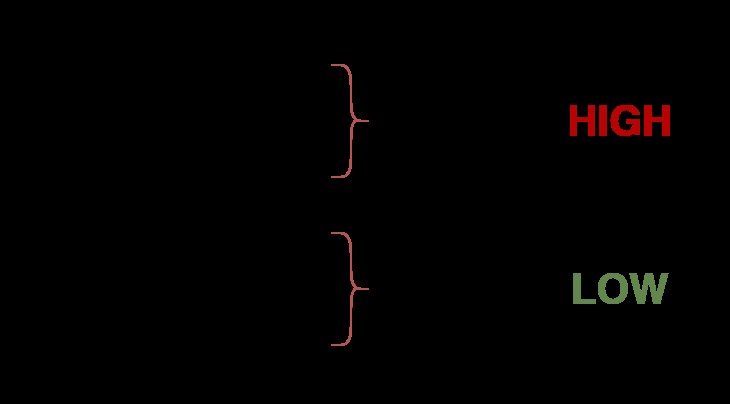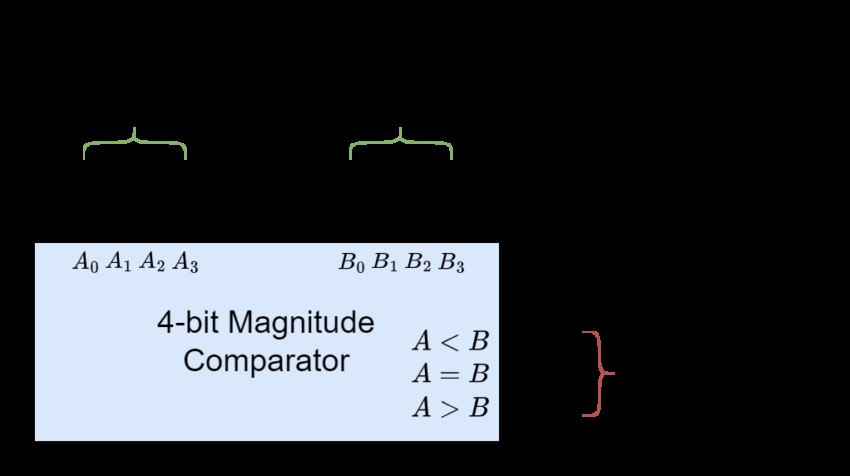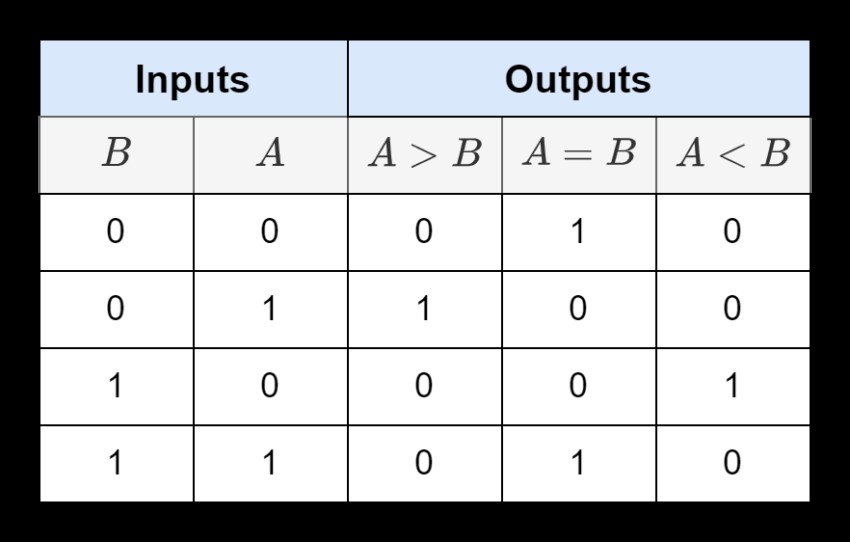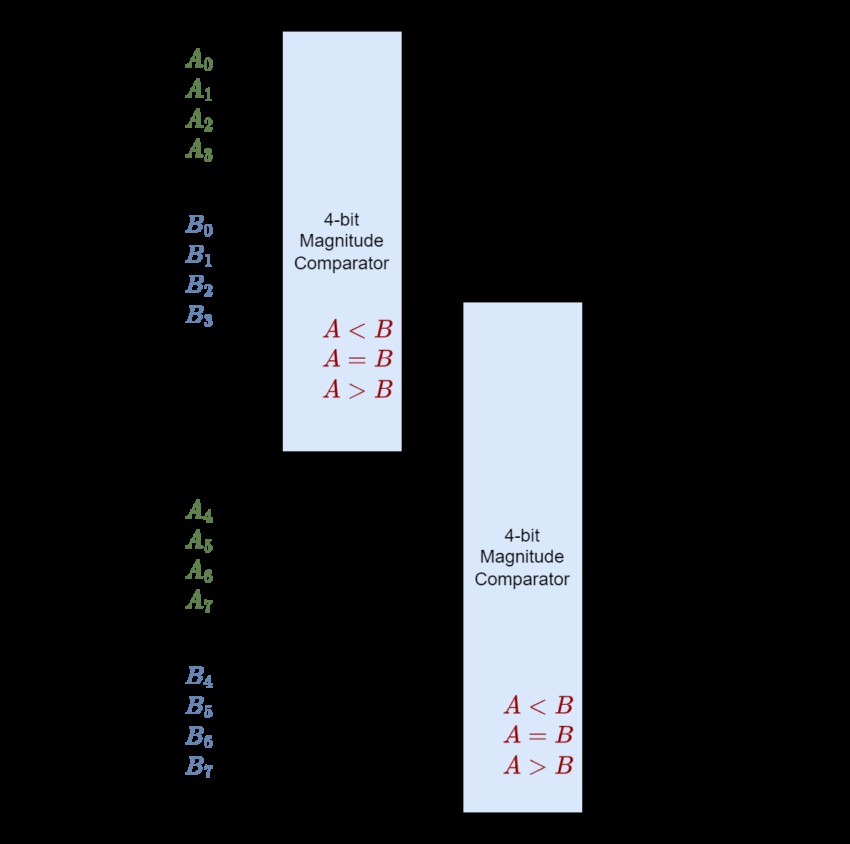What Is A Digital Comparator? COMPARE.EDU.VN explains that a digital comparator is a crucial component in digital electronics, used to compare binary numbers and determine their relationship. This article dives deep into the world of digital comparators, exploring their types, working principles, applications, and advantages, offering a comprehensive guide for students, engineers, and anyone interested in digital logic circuits. Discover how digital comparators enable essential decision-making capabilities in various electronic systems.
1. Introduction to Digital Comparators
In the realm of digital electronics, the ability to compare digital values is fundamental. A digital comparator is a combinational logic circuit that performs this critical function. It takes two binary numbers as input and determines whether they are equal, or if one is greater or less than the other. These circuits are essential in various applications, from simple control systems to complex arithmetic logic units (ALUs). Digital comparators are the cornerstone of decision-making processes within digital systems.
COMPARE.EDU.VN provides a comprehensive guide to understanding digital comparators, detailing their construction using basic logic gates, different types, and practical applications. Whether you are a student learning about digital circuits or an engineer designing complex systems, this resource offers valuable insights into the functionality and implementation of digital comparators. Understanding comparators is key to grasping digital logic and is crucial for those looking to make informed decisions in their designs.
2. Understanding the Basics of Digital Comparators
A digital comparator is a combinational circuit that compares two binary numbers to determine their relationship. The output of a digital comparator typically indicates whether the two inputs are equal, one is greater than the other, or one is less than the other. This comparison is based on the binary representation of the input numbers.
2.1. Combinational Logic
Digital comparators fall under the category of combinational logic circuits. These circuits produce outputs that depend solely on their current inputs, without any memory or feedback. In contrast to sequential logic circuits, which incorporate memory elements, combinational circuits are memoryless. This makes them ideal for real-time comparison tasks where the output needs to reflect the current input values instantly.
2.2. Binary Number Comparison
The heart of a digital comparator lies in its ability to compare binary numbers. Binary numbers are composed of bits, each representing a 0 or 1. The comparator examines these bits from the most significant bit (MSB) to the least significant bit (LSB) to determine the relationship between the two numbers. This bit-by-bit comparison is crucial for accurately determining if the numbers are equal, greater than, or less than each other.
2.3. Output Indicators
Digital comparators typically have three output indicators to represent the relationship between the two input numbers. These indicators are:
- A = B: This output is high (1) when the two input numbers (A and B) are equal.
- A > B: This output is high when input A is greater than input B.
- A < B: This output is high when input A is less than input B.
These output indicators provide a clear and direct way to understand the comparison result, making digital comparators versatile for a wide range of applications.
3. Types of Digital Comparators
Digital comparators come in various forms, each designed to meet specific requirements and applications. The primary types of digital comparators include:
3.1. Identity Comparator
The identity comparator, also known as an equality comparator, is the simplest form of digital comparator. Its sole purpose is to determine whether two input numbers are identical. It has a single output that goes high (1) if the two inputs are equal and low (0) if they are not. Identity comparators are useful in applications where you need to verify that two values match exactly, such as in data validation and memory addressing.
The identity comparator compares two inputs and provides a HIGH output if they are identical.
3.2. Magnitude Comparator
A magnitude comparator provides more detailed information about the relationship between two input numbers. In addition to determining equality, it also indicates whether one number is greater than or less than the other. As mentioned earlier, a magnitude comparator has three outputs:
- A = B: Indicates that input A is equal to input B.
- A > B: Indicates that input A is greater than input B.
- A < B: Indicates that input A is less than input B.
Magnitude comparators are widely used in applications such as sorting algorithms, process control systems, and decision-making circuits.
The magnitude comparator not only checks for equality but also determines if one input is greater or less than the other.
3.3. Single-Bit Comparator
A single-bit comparator compares two single-bit inputs and produces outputs based on their relationship. It is the most basic type of digital comparator and serves as a building block for more complex multi-bit comparators. Single-bit comparators are often implemented using basic logic gates such as AND, OR, and XOR gates.
3.4. Multi-Bit Comparator
Multi-bit comparators extend the functionality of single-bit comparators to handle binary numbers with multiple bits. These comparators use a combination of single-bit comparators and additional logic to compare each bit position and determine the overall relationship between the two numbers. Multi-bit comparators are essential in applications that involve comparing larger binary values, such as in microprocessors and digital signal processing systems.
3.5. 4-Bit Magnitude Comparator
A 4-bit magnitude comparator is a specific type of multi-bit comparator that compares two 4-bit binary numbers. It is commonly used in applications where data is processed in nibbles (4-bit units). The 4-bit magnitude comparator can be cascaded to create comparators for larger binary numbers.
This 4-bit comparator is used to compare binary numbers with the output indicating if A < B, A = B, or A > B.
4. Constructing a Digital Comparator
Digital comparators can be constructed using basic logic gates or integrated circuits specifically designed for comparison.
4.1. Using Basic Logic Gates
A digital comparator can be built using a combination of AND, OR, and XOR (Exclusive OR) gates. The exact configuration depends on the type of comparator being implemented.
- Identity Comparator: An identity comparator can be implemented using an XOR gate followed by a NOT gate. The output is high when the two inputs are equal because the XOR gate outputs low only when the inputs are the same. The NOT gate inverts this signal, providing a high output for equal inputs.
- Magnitude Comparator: A magnitude comparator requires a more complex arrangement of logic gates. It involves comparing each bit position and generating the appropriate outputs based on the bit comparisons. The design typically involves XOR gates to compare each bit, AND gates to determine if A > B or A < B, and OR gates to combine the results.
4.2. Integrated Circuits (ICs)
Integrated circuits (ICs) designed specifically for digital comparison offer a convenient and efficient way to implement comparators. These ICs contain all the necessary logic gates and circuitry to perform the comparison function in a single chip. Some popular comparator ICs include the TTL 74LS85 and the CMOS 4063. These ICs are widely used due to their ease of use, reliability, and performance.
4.3. Truth Table for a 1-Bit Digital Comparator
To understand the operation of a digital comparator, it is essential to examine its truth table. The truth table for a 1-bit digital comparator illustrates the relationship between the inputs (A and B) and the outputs (A = B, A > B, A < B).
| A | B | A = B | A > B | A < B |
|---|---|---|---|---|
| 0 | 0 | 1 | 0 | 0 |
| 0 | 1 | 0 | 0 | 1 |
| 1 | 0 | 0 | 1 | 0 |
| 1 | 1 | 1 | 0 | 0 |





This truth table clearly shows how the comparator outputs respond to different input combinations. For example, when A and B are both 0 or both 1, the A = B output is high, indicating equality.
This truth table outlines the relationship between inputs A and B and the resulting outputs for A = B, A > B, and A < B.
5. Applications of Digital Comparators
Digital comparators are integral to various electronic systems and applications due to their ability to perform binary comparisons.
5.1. Arithmetic Logic Units (ALUs)
Arithmetic Logic Units (ALUs) are fundamental components of computer processors. They perform arithmetic and logical operations, including addition, subtraction, AND, OR, and comparison. Digital comparators are used within ALUs to perform comparison operations, which are essential for decision-making and control flow in computer programs.
5.2. Process Control Systems
In process control systems, digital comparators are used to monitor and control various parameters, such as temperature, pressure, and flow rate. By comparing the actual value of a parameter with a desired setpoint, the comparator can trigger alarms or initiate corrective actions to maintain the system within the desired operating range.
5.3. Analog-to-Digital Converters (ADCs)
Analog-to-Digital Converters (ADCs) convert analog signals into digital values. Digital comparators play a crucial role in ADCs by comparing the analog input voltage with a series of reference voltages to determine the corresponding digital output code.
5.4. Sorting Algorithms
Sorting algorithms, such as bubble sort and quicksort, rely on comparisons to arrange data in a specific order. Digital comparators are used to compare the values of data elements and determine their relative order, enabling the sorting algorithm to correctly arrange the data.
5.5. Memory Addressing
In memory systems, digital comparators are used for address decoding. They compare the address requested by the processor with the available memory addresses to determine if the requested address is valid. This ensures that the processor accesses the correct memory location.
5.6. Robotics
Robotics utilizes digital comparators in sensor systems to make decisions based on sensor readings. For example, a robot might use comparators to determine if it is close to an obstacle and needs to change direction.
5.7. Automotive Electronics
In automotive electronics, digital comparators are used in various control systems, such as engine control units (ECUs) and anti-lock braking systems (ABS). They compare sensor data to predefined thresholds and initiate actions to improve vehicle performance and safety.
6. Advantages and Disadvantages of Digital Comparators
Like any electronic component, digital comparators have their strengths and limitations.
6.1. Advantages
- High Speed: Digital comparators can perform comparisons very quickly, making them suitable for real-time applications.
- Accuracy: They provide accurate comparisons based on the binary representation of the input numbers.
- Ease of Use: Comparator ICs are easy to integrate into digital systems, simplifying the design process.
- Versatility: Digital comparators can be used in a wide range of applications, from simple control circuits to complex systems.
- Reliability: Properly designed digital comparators are highly reliable and can operate consistently over extended periods.
6.2. Disadvantages
- Complexity: Implementing magnitude comparators using basic logic gates can be complex and require a significant number of components.
- Power Consumption: Comparators can consume power, especially in high-speed applications.
- Limited Input Range: Digital comparators are designed to compare digital values, and their input range is limited by the supply voltage.
- Susceptibility to Noise: Like other digital circuits, comparators can be susceptible to noise, which can affect the accuracy of the comparison.
- Static Discharge Sensitivity: Many comparator ICs are sensitive to static discharge, which can damage the chip if not handled carefully.
7. Cascading Digital Comparators
Cascading digital comparators involves connecting multiple comparators together to compare binary numbers with a larger number of bits. This is particularly useful when comparing numbers that exceed the bit capacity of a single comparator. The cascading method allows for the expansion of the comparison capability by using the outputs of one comparator as inputs to the next.
Cascading two 4-bit comparators allows for the comparison of 8-bit binary numbers, expanding the comparison capability.
7.1. How Cascading Works
The cascading process typically involves connecting the A = B, A > B, and A < B outputs of one comparator to the corresponding inputs of the next comparator. The comparator comparing the most significant bits (MSBs) feeds its outputs to the next comparator, which handles the less significant bits. This arrangement allows for a systematic comparison, ensuring accuracy across the entire range of bits.
7.2. Advantages of Cascading
- Increased Bit Capacity: Cascading allows for the comparison of binary numbers with any number of bits, overcoming the limitations of single comparators.
- Modularity: The modular nature of cascading allows designers to easily expand the comparison capability by adding more comparators.
- Flexibility: Cascading provides flexibility in designing custom comparison circuits tailored to specific application requirements.
7.3. Considerations for Cascading
- Propagation Delay: Cascading introduces additional propagation delay, which can affect the overall speed of the comparison. Designers need to consider this delay when designing high-speed systems.
- Noise Accumulation: Noise can accumulate as signals pass through multiple comparators, potentially affecting the accuracy of the comparison. Proper signal conditioning and noise reduction techniques may be necessary.
- Power Consumption: Each comparator in the cascade consumes power, and the total power consumption increases with the number of comparators. Power management techniques may be needed to minimize power consumption.
8. Practical Examples of Digital Comparator Circuits
To illustrate the practical application of digital comparators, let’s consider a few examples.
8.1. Simple Alarm System
In a simple alarm system, a digital comparator can be used to compare the value of a sensor with a predefined threshold. For example, a temperature sensor can be connected to an ADC, which converts the analog temperature signal into a digital value. A digital comparator then compares this digital value with a threshold representing the desired temperature range. If the temperature exceeds the threshold, the comparator triggers an alarm.
8.2. Motor Control System
In a motor control system, a digital comparator can be used to compare the actual speed of a motor with a desired speed. A speed sensor provides feedback on the motor’s actual speed, which is then converted into a digital value. The comparator compares this value with the desired speed setting. Based on the comparison result, the control system adjusts the motor’s power to maintain the desired speed.
8.3. Digital Thermostat
A digital thermostat uses a comparator to maintain a set temperature. A temperature sensor provides a digital reading, which is compared to the setpoint. If the temperature is below the setpoint, the comparator activates the heating system; if it’s above, the cooling system is activated.
9. Future Trends in Digital Comparators
The field of digital comparators continues to evolve with advancements in technology. Some future trends include:
9.1. Low-Power Comparators
As energy efficiency becomes increasingly important, there is a growing demand for low-power comparators. These comparators are designed to minimize power consumption without sacrificing performance.
9.2. High-Speed Comparators
High-speed comparators are essential for applications that require fast comparison operations, such as in high-speed data acquisition systems and communication networks.
9.3. Integrated Comparators
Integrated comparators combine the comparator functionality with other digital circuits, such as ADCs and microcontrollers, into a single chip. This integration reduces the size, cost, and complexity of digital systems.
9.4. Adaptive Comparators
Adaptive comparators can adjust their performance based on the input signal characteristics. This adaptability allows them to optimize performance in various operating conditions.
9.5. Quantum Comparators
With the emergence of quantum computing, quantum comparators are being developed to compare quantum information. These comparators leverage the principles of quantum mechanics to perform comparison operations on quantum bits (qubits).
10. Conclusion: Mastering Digital Comparators for Efficient Decision Making
Digital comparators are indispensable components in digital electronics, enabling essential decision-making capabilities in various electronic systems. Their ability to compare binary numbers and determine their relationship is fundamental to a wide range of applications, from simple control systems to complex arithmetic logic units (ALUs). Understanding the types, construction, applications, and advantages of digital comparators is crucial for students, engineers, and anyone interested in digital logic circuits.
COMPARE.EDU.VN offers a wealth of information and resources to help you master digital comparators and other aspects of digital electronics. By exploring the detailed guides, tutorials, and examples available on COMPARE.EDU.VN, you can gain a deeper understanding of digital comparators and their role in modern technology. This knowledge will empower you to design more efficient, reliable, and innovative electronic systems.
Ready to take your understanding of digital comparators to the next level? Visit COMPARE.EDU.VN today to access comprehensive resources and expert insights that will help you make informed decisions and excel in your digital electronics endeavors. Whether you’re comparing digital circuits or choosing the right components for your project, COMPARE.EDU.VN is your trusted partner in digital electronics education and comparison.
Address: 333 Comparison Plaza, Choice City, CA 90210, United States
WhatsApp: +1 (626) 555-9090
Website: compare.edu.vn
11. Frequently Asked Questions (FAQs) about Digital Comparators
1. What is a digital comparator?
A digital comparator is a combinational logic circuit that compares two binary numbers to determine their relationship (equal, greater than, or less than).
2. What are the main types of digital comparators?
The main types are identity comparators (which only check for equality) and magnitude comparators (which determine if one number is greater than or less than the other).
3. How does a digital comparator work?
A digital comparator compares two binary inputs bit by bit, typically from the most significant bit (MSB) to the least significant bit (LSB), and outputs signals indicating the relationship between the numbers.
4. What logic gates are used to construct a digital comparator?
Digital comparators can be constructed using AND, OR, XOR (Exclusive OR), and NOT gates. The specific arrangement depends on the type of comparator.
5. What are some common applications of digital comparators?
Common applications include arithmetic logic units (ALUs), process control systems, analog-to-digital converters (ADCs), sorting algorithms, and memory addressing.
6. What are the advantages of using digital comparators?
Advantages include high speed, accuracy, ease of use (especially with comparator ICs), versatility, and reliability.
7. What are the disadvantages of using digital comparators?
Disadvantages include complexity (for magnitude comparators), power consumption, limited input range, susceptibility to noise, and sensitivity to static discharge.
8. How can digital comparators be cascaded?
Digital comparators can be cascaded by connecting the A = B, A > B, and A < B outputs of one comparator to the corresponding inputs of the next comparator. This allows for the comparison of binary numbers with a larger number of bits.
9. What is a 4-bit magnitude comparator?
A 4-bit magnitude comparator is a type of multi-bit comparator that compares two 4-bit binary numbers and provides outputs indicating if one number is equal to, greater than, or less than the other.
10. What are some popular digital comparator ICs?
Popular digital comparator ICs include the TTL 74LS85 and the CMOS 4063.
By providing clear and concise answers to these common questions, this FAQ section enhances the article’s value and provides readers with a quick reference for understanding digital comparators.